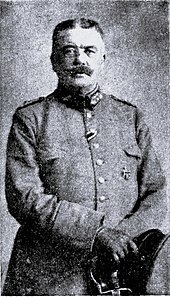Carl von Wichmann
Carl Franz Hermann von Wichmann (born April 11, 1860 in Bromberg ; † May 11, 1922 ) was a Prussian lieutenant general .
Life
origin
He was the son of the later Prussian general of the cavalry Hermann von Wichmann (1820–1886) and his wife Helene, née von Borcke (1838–1884).
Military career
On April 1, 1880, Wichmann joined the 1st Magdeburg Infantry Regiment No. 26 of the Prussian Army as a portepeef ensign . There he was promoted to Second Lieutenant on October 18, 1881 . In the following years he served first as adjutant of the 1st battalion, then as regimental adjutant. As Prime Lieutenant , Wichmann was adjutant of the 50th Infantry Brigade from September 21, 1889 to September 13, 1893 . Subsequently, with his promotion to captain, he was appointed company commander in the grenadier regiment "King Wilhelm I." (2nd West Prussian) No. 7 . This was followed by a command from 1898 to 1903 as adjutant of the General Command of the V Army Corps . On April 18, 1903, Wichmann returned to the service and was battalion commander in the 1st East Prussian Grenadier Regiment No. 1 "Crown Prince" in Königsberg . In this position promoted to lieutenant colonel on December 19, 1907 , he was transferred to the staff of the 4th Lower Silesian Infantry Regiment No. 51 in Breslau on January 27, 1908 . He was then as a colonel from March 20, 1911 to July 1, 1913 commander of the fusilier regiment "Queen Victoria of Sweden" (Pomeranian) No. 34 in Stettin. Subsequently, Wichmann resigned from the army and joined the Imperial Navy . Here he was appointed inspector of the marine infantry and entrusted with the management of business as the commandant of Kiel . Wichmann was awarded the Order of the Crown, Second Class , on January 20, 1914 and was promoted to Major General seven days later .
After the beginning of the First World War , Wichmann was command of the Marine Infantry Brigade from August 27 to December 7, 1914. She was part of the Marine Division under Admiral Ludwig von Schröder . Then he left the Imperial Navy again, stepped back into the Prussian Army and was on 10 December 1914 commander of the 81st Infantry Brigade appointed that at this time in position battles west Roye - Noyon was.
On the side facing the enemy side of the loopholes small bushes were plugged by order Wichmann. For that, the name "Wichmannbüsche" quickly became established. Wichmann had received the Hanseatic Cross of the city of Lübeck on November 3, 1915 .
On February 21, 1916, the day on which the Battle of Verdun began, Wichmann headed the " Hamburg " company. To the east of the Souchez brook there was a height (the so-called "Gießler-Höhe"), the possession of which, similar to the Loretto height , gave the enemy considerable strategic advantages. This height was successfully conquered with the company. The painter Hans am Ende , fighting in the ranks of the brigade, recorded the height from the perspective of the brigade regiments, ( 162 ) and ( 163 ), for them in a watercolor .
On April 3, 1916, he took over the 44th Reserve Division off Verdun . From June 18, 1916, Wichmann was in command of the 56th Division . His achievements during the fighting on the Western Front were honored on October 25, 1916 by being awarded the Order of the Red Eagle, 2nd Class with Oak Leaves and Swords. At the end of the year he was promoted to lieutenant general. Wichmann was released from his post on July 1, 1918 and finally put up for disposition on October 14, 1918 with the statutory pension in approval of his resignation request.
literature
- Otto Dziobek : History of the Lübeck Infantry Regiment (3rd Hanseatic) No. 162. Gerhard Stalling publishing house, Oldenburg 1922, officers' association formerly 162 .
- Holger Ritter: History of the Schleswig-Holstein Infantry Regiment No. 163. Leuchtfeuer Verlag, Hamburg 1926, Volume 184 of the Prussian. Share of the reminder sheets.
- Major General von Wichmann. In: Father-city sheets . No. 16 of January 17, 1915.
- Marcelli Janecki : Handbook of the Prussian Nobility. First volume, ES Mittler & Sohn , Berlin 1892, pp. 603–604.
Individual evidence
- ^ Kurt von Priesdorff : Soldatisches Führertum . Volume 8, Hanseatische Verlagsanstalt Hamburg, undated [Hamburg], undated [1941], DNB 367632837 , pp. 408f., No. 2671.
- ^ History of the Grenadier Regiment King Wilhelm I. (2nd West Prussian) No. 7. First volume, Verlag Carl Fleming, Glogau 1897, p. 102.
- ^ Günter Wegmann (Ed.), Günter Wegner: Formation history and staffing of the German armed forces 1815-1990. Part 1: Occupation of the German armies 1815–1939. Volume 2: The staffing of the active infantry regiments as well as Jäger and MG battalions, military district commands and training managers from the foundation and / or list until 1939. Biblio Verlag, Osnabrück 1992, ISBN 3-7648-1782-8 , p. 125.
- ^ Military weekly paper . No. 87 of July 3, 1913, p. 1983.
- ↑ Lübeck city archives in terms of Senate files: Directory of the owner of the Lübeckischen Hanseatic Cross. Signature 1093.
- ^ Military weekly paper. No. 81 of October 28, 1916. p. 1843.
- ^ Military weekly paper. No. 49 of October 22, 1918, p. 806.
| personal data | |
|---|---|
| SURNAME | Wichmann, Carl von |
| ALTERNATIVE NAMES | Wichmann, Carl Franz Hermann von |
| BRIEF DESCRIPTION | Prussian lieutenant general |
| DATE OF BIRTH | April 11, 1860 |
| PLACE OF BIRTH | Bromberg |
| DATE OF DEATH | May 11, 1922 |

